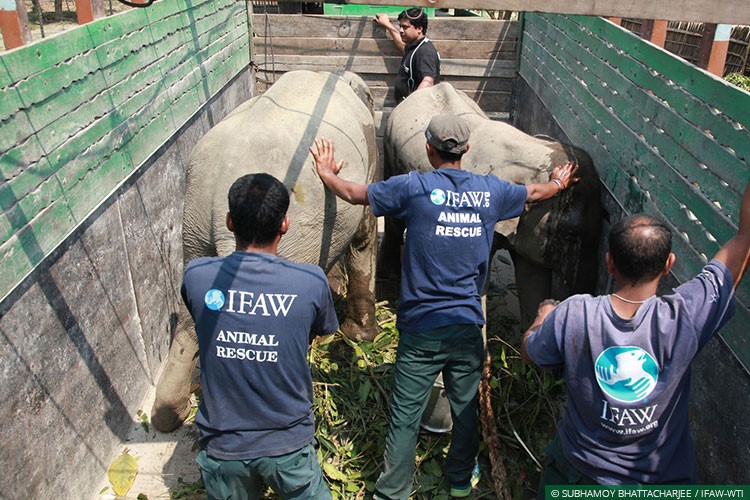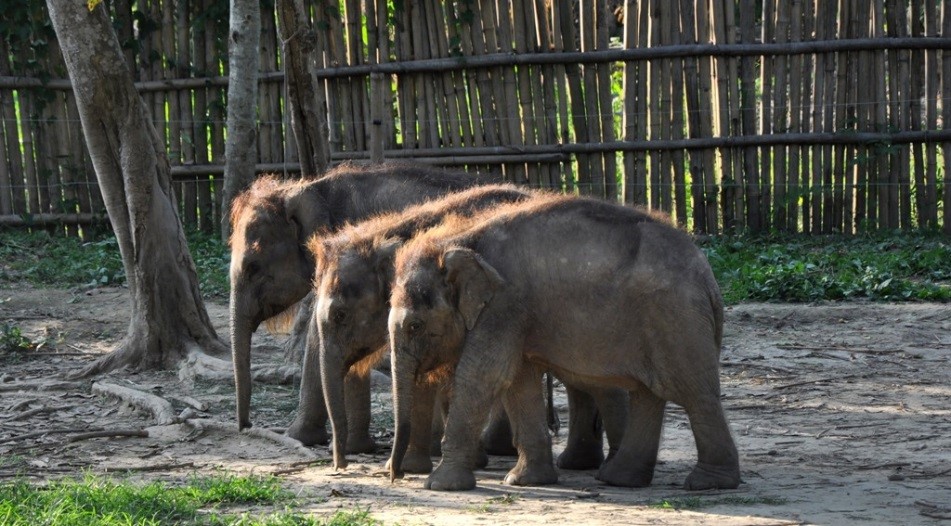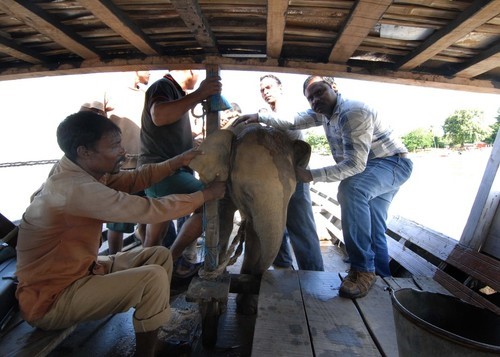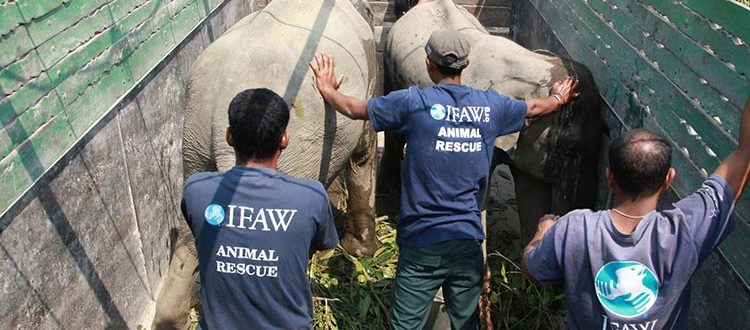From being stranded to being free. Giving a new lease of life back in the wild!
About a year back, six elephant calves along with a team of veterinarians, animal keepers and forest department staff braved an 11-hour journey from Kaziranga to Manas National Park. The team had only one purpose: to give these orphaned elephant calves an opportunity to be able to roam freely in the wild. These elephant calves were a part of the mammoth effort taken by Wildlife Trust of India (WTI), International Fund for Animal Welfare (IFAW) and Assam Forest Department (AFD) to be rescued and rehabilitated back to the wild while also reinforcing the conservation efforts in Manas National Park, Assam. One would suppose this as just another journey of 11-hours, but the truth was beyond one’s imagination.

Since 2008, IFAW-WTI and Assam Forest Department initiated the elephant rehabilitation program in Manas National Park. The prime objective of the program was to bring the glory of Manas National Park back to the pre-civil unrest days by restocking megafauna like Greater One-Horned hinoceros and Asian elephants. The secondary aim after the rescue of these displaced and orphaned elephant calves was to send them back to the wild. It was envisioned and carried out at the Centre for Wildlife Rehabilitation and Conservation (CWRC): a wildlife rehabilitation facility founded by the IFAW-WTI in collaboration with AFD near Kaziranga National Park. This is where the story begins, and the prime characters were the six female elephant calves, born in different geographical areas, but were destined to be raised with each other and live a life together in the wild!
Dhemaji (she got her name after the place she was rescued from on the Northern Banks of Brahmaputra River) was the first of the six calves to be admitted to CWRC in 2013. She was found stranded after being swept in the flood waters away from her kin. Reuniting her with the natal herd was impossible as the team could not locate any herd nearby. She was brought to CWRC and joined the existing elephant calves at the centre. She assimilated well with the new family. This faux herd was though short- lived, as five of these calves were moved to Manas in 2014 to be released. Dhemaji, however, soon was joined by another young calf, Ghajini, 8 months after she came to the centre.
Ghajini, the second character in this tale, suffered a grim history that she came out of bravely. Ghajini (named after a Hindi/Tamil movie in which the protagonist bore a huge scar on his head) was rescued from Missa near Nagaon in Central Assam. She was found, like the protagonist of the movie with a huge scar on her head after she was hacked by some locals. CWRC team immediately rescued the calf and took her to CWRC. After months of intensive treatment, her wound started healing and she started recovering. Dhemaji and she being almost of the same age, bonded well.
 Two months later in December, our third character enters the plot: Karbi. Karbi was rescued from Ouguri Range, Karbi Anglong after she was found fallen in a ditch on a hill slope. The mother was nowhere to be found and the team took the calf to join Dhemaji and Ghajini at CWRC. Karbi was a weak calf in contrast to the other two and therefore required more care from the caretakers at CWRC. However, she responded well and started recovering. The team was happy to see this new faux herd forming at the centre and hoped that these calves will soon roam the vast forests and grasslands of Manas National Park.
Two months later in December, our third character enters the plot: Karbi. Karbi was rescued from Ouguri Range, Karbi Anglong after she was found fallen in a ditch on a hill slope. The mother was nowhere to be found and the team took the calf to join Dhemaji and Ghajini at CWRC. Karbi was a weak calf in contrast to the other two and therefore required more care from the caretakers at CWRC. However, she responded well and started recovering. The team was happy to see this new faux herd forming at the centre and hoped that these calves will soon roam the vast forests and grasslands of Manas National Park.
Kumari (the animal keepers at CWRC often name the elephant calves from the place where they are rescued for identification) was admitted to CWRC in 2014 from Kumarikhata, near the Manas National Park. She was left only after the herd came into a position of struggle with humans and fled the place. Kumari was older than the other calves and due to lack of facility of raising the calf in Manas had to be brought to CWRC: A journey that she would again undertake three years later to return as the daughter of the soil!
The account is nearing its final stage but would be incomplete without mentioning our fifth character, Usha. Her tale is truly unbelievable and for what she went through, she can be an inspiration to one and all. 
Usha was spotted along with her mother and older brother on an island stranded after the flood waters disconnected the landmass with any other drier landmass. Usha’s mother was extremely sick and mostly recumbent. The team provided her with food and supportive medicines, but she eventually succumbed leaving two of her children orphaned. Usha, younger and probably more dependent on her mother, was visibly distraught by the passing. The team decided to immediately rescue her and move her to CWRC to be inducted into the rehabilitation program. Her brother, older and bigger was later also captured, but upon being found unfit for rehabilitation was sent to the forest department camp to be used as a captive elephant. Usha in the meantime reached CWRC and met the other characters. The team felt that having lived in the wild with the mother handed her extra confidence and she would prefer to stay with the calves, only and not the keepers! This was a good sign as this indicated that she was less used to humans and better chances of post- release survival and reintegration to the wild. The last character Ultee (as she was rescued from Ultapani near Manas National Park) was brought in to CWRC in early 2015. She had a minor deformity on her trunk, but that didn’t stop her from joining the others to Manas National Park.
The six elephant calves were fitted with radio collars to facilitate their monitoring post-release. They were initially held in a Boma (enclosure) at Manas NP to allow them to acclimatize to life in the wild. After being kept for a month, they were allowed to roam freely in April 2018. A team of biologists, animal keepers and wildlife veterinarians monitored the animals to document their health, movement and any shreds of evidences of interaction with wild elephants. It has been a year since they were moved and released in Manas NP and all of the six are surviving. One elephant, Karbi has gone missing after she was seen begging from on-going traffic on a national highway on India-Bhutan border. For the initial six months, all the elephants moved together, taking the small forest roads, exploring the landscape and occasionally coming close to a few anti-poaching camps that probably reminded them of their life at CWRC. In these six months, the faux herd covered an approximate area of 146 sq.km. After six months, the faux herd started disintegrating into multiple units: Dhemaji and Ghajini moved together, Usha and Ultee moved to the southeast region of the park while Karbi and Kumari remained solitary.
Usha was fitted with a satellite radio collar in December to monitor her movement intensively. She has been travelling constantly and Ultee is not with her anymore. The health of all the five elephant calves being monitored is good and they are slowly getting to learn the ways of the wild. We hope they continue to survive and thrive in their new home and are optimistic that they will soon meet a wild elephant herd, which will accept them as their very own bringing their beautiful story to end and to start an even better one back in the wild!
Abhishek Narayanan, author of this blog heads the Wild Rescue and Rehabilitation division at Wildlife Trust of India. He can be reached at abhishek@wti.org.in









